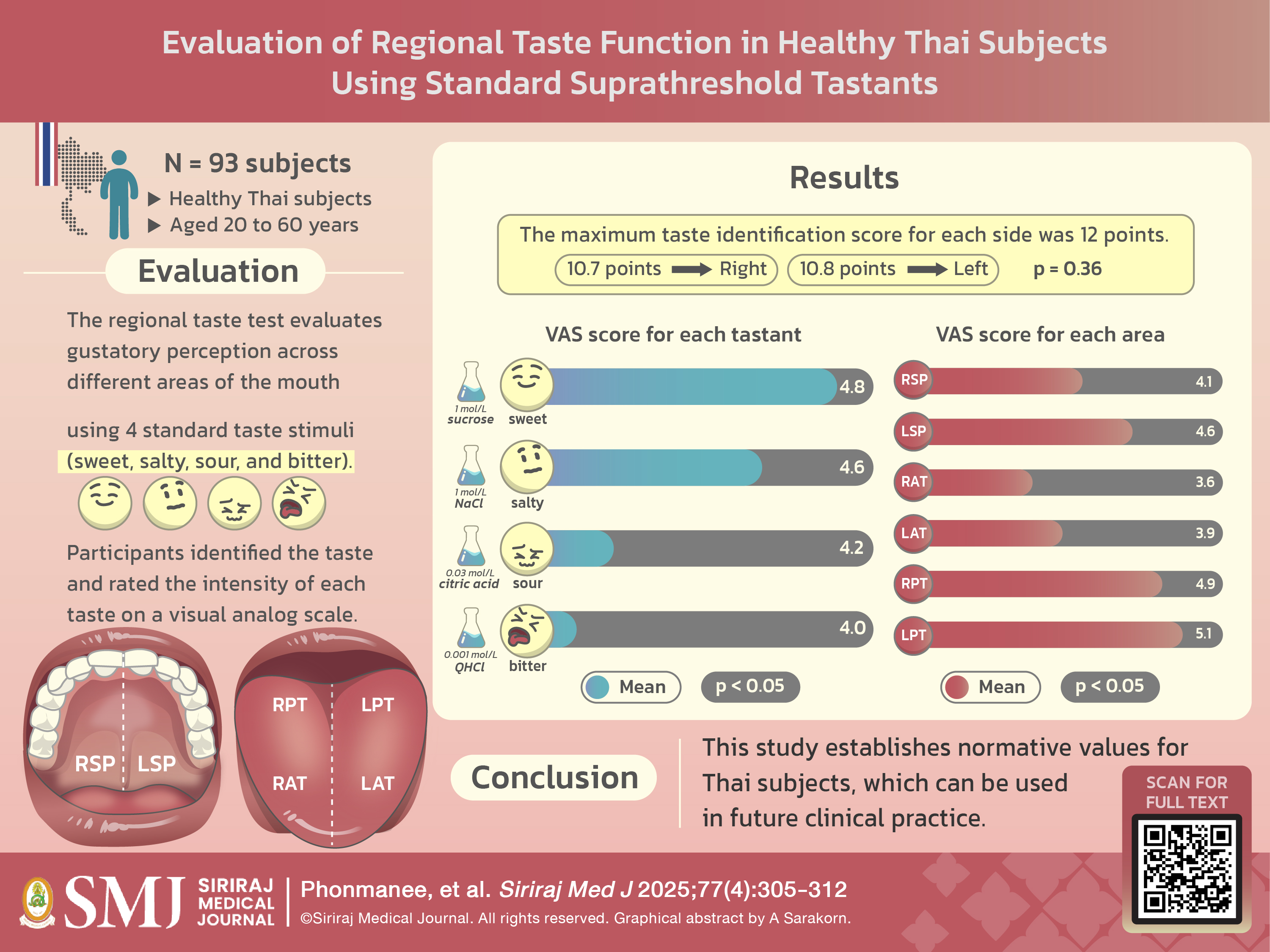Evaluation of Regional Taste Function in Healthy Thai Subjects Using Standard Suprathreshold Tastants
DOI:
https://doi.org/10.33192/smj.v77i4.272535Keywords:
Regional taste test, spatial taste test, gustatory test, gustatory functionAbstract
Objective: To evaluate regional taste function in normal Thai subjects using standard suprathreshold tastants.
Materials and Methods: A total of 93 healthy Thai subjects (41 males and 52 females), aged 20 to 60 years, were recruited. Regional taste function was assessed using four standard suprathreshold tastants, with both identification scores and VAS scores recorded.
Results: The mean total taste identification score was 10.7 on the right side and 10.8 on the left side, with no statistically significant differences between sides across all subgroups. The mean VAS score was highest for sweet tastants and for the posterior tongue as the tested area. No significant differences were observed between sexes or among age groups when analyzed by tastant and area.
Conclusion: The regional (spatial) taste test is a useful gustatory test. This study establishes normative values for Thai subjects, which can be used in future clinical practice for patient evaluations.
References
Daly BP, Daly MP, Minniti N, Daly JM. Sense of Taste (Effect on Behavior). In: Ramachandran VS, editor. Encyclopedia of Human Behavior (Second Edition). San Diego: Academic Press; 2012. p. 373-8.
Gonzales GM, Cook MJ. CHAPTER 13 - DISORDERS OF SMELL AND TASTE. In: Schapira AHV, Byrne E, DiMauro S, Frackowiak RSJ, Johnson RT, Mizuno Y, et al., editors. Neurology and Clinical Neuroscience. Philadelphia: Mosby; 2007. p.171-7.
Liu G, Zong G, Doty RL, Sun Q. Prevalence and risk factors of taste and smell impairment in a nationwide representative sample of the US population: a cross-sectional study. BMJ Open. 2016;6(11):e013246.
Deems DA, Doty RL, Settle RG, Moore-Gillon V, Shaman P, Mester AF, et al. Smell and taste disorders, a study of 750 patients from the University of Pennsylvania Smell and Taste Center. Arch Otolaryngol Head Neck Surg. 1991;117(5):519-28.
Hur K, Choi JS, Zheng M, Shen J, Wrobel B. Association of alterations in smell and taste with depression in older adults. Laryngoscope Investig Otolaryngol. 2018;3(2):94-9.
Pinkaew B, Assanasen P, Michel O, Talek K, Phonmanee T, Kerdnoppakhun J. Impact Assessment of Smell and Taste Disorders on Quality of Life in Thais Using the SF-36 Health Survey (Thai version). Siriraj Med J. 2019;71(2):102-9.
Soter A, Kim J, Jackman A, Tourbier I, Kaul A, Doty RL. Accuracy of self-report in detecting taste dysfunction. Laryngoscope. 2008;118(4):611-7.
Bartoshuk L. Clinical evaluation of the sense of taste. Ear Nose Throat J. 1989;68(4):331-7.
Ikui A. A review of objective measures of gustatory function. Acta Otolaryngol Suppl. 2002(546):60-8.
Tomita H, Ikeda M, Okuda Y. Basis and practice of clinical taste examinations. Auris Nasus Larynx. 1986;13 Suppl 1:S1-15.
Mueller C, Kallert S, Renner B, Stiassny K, Temmel AF, Hummel T, et al. Quantitative assessment of gustatory function in a clinical context using impregnated “taste strips”. Rhinology. 2003;41(1):2-6.
Ahne G, Erras A, Hummel T, Kobal G. Assessment of gustatory function by means of tasting tablets. Laryngoscope. 2000;110(8):1396-401.
Spence C. The tongue map and the spatial modulation of taste perception. Curr Res Food Sci. 2022;5:598-610.
Finger TE, Kinnamon SC. Taste isn’t just for taste buds anymore. F1000 Biol Rep. 2011;3:20.
Matsuda T, Doty RL. Regional taste sensitivity to NaCl: relationship to subject age, tongue locus and area of stimulation. Chem Senses. 1995;20(3):283-90.
Barragán R, Coltell O, Portolés O, Asensio EM, Sorlí JV, Ortega-Azorín C, et al. Bitter, Sweet, Salty, Sour and Umami Taste Perception Decreases with Age: Sex-Specific Analysis, Modulation by Genetic Variants and Taste-Preference Associations in 18 to 80 Year-Old Subjects. Nutrients. 2018;10(10).
Rea P. Chapter 2 - Head. In: Rea P, editor. Essential Clinically Applied Anatomy of the Peripheral Nervous System in the Head and Neck: Academic Press; 2016. p. 21-130.
Sato K, Endo S, Tomita H. Sensitivity of three loci on the tongue and soft palate to four basic tastes in smokers and non-smokers. Acta Otolaryngol Suppl. 2002(546):74-82.
Nilsson B. Taste acuity of the human palate. III. Studies with taste solutions on subjects in different age groups. Acta Odontol Scand. 1979;37(4):235-52.
Collings VB. Human taste response as a function of locus of stimulation on the tongue and soft palate. Perception & Psychophysics. 1974;16(1):169-74.
Feeney EL, Hayes JE. Regional differences in suprathreshold intensity for bitter and umami stimuli. Chemosens Percept. 2014;7(3-4):147-57.
Mojet J, Christ-Hazelhof E, Heidema J. Taste perception with age: generic or specific losses in threshold sensitivity to the five basic tastes? Chem Senses. 2001;26(7):845-60.
da Silva LA, Lin SM, Teixeira MJ, de Siqueira JT, Jacob Filho W, de Siqueira S. Sensorial differences according to sex and ages. Oral Dis. 2014;20(3):e103-10.
Bartoshuk LM, Duffy VB, Miller IJ. PTC/PROP tasting: anatomy, psychophysics, and sex effects. Physiol Behav. 1994;56(6):1165-71.
Williams JA, Bartoshuk LM, Fillingim RB, Dotson CD. Exploring Ethnic Differences in Taste Perception. Chem Senses. 2016;41(5):449-56.
Bowser S, Farnsworth N, Russell K, Schlechter H, Bernstein S, Courville AB, et al. Sweet taste perception is greater in non-Hispanic black than in non-Hispanic white adults. Nutrition. 2019;59:103-7.
Yang Q, Williamson A-M, Hasted A, Hort J. Exploring the relationships between taste phenotypes, genotypes, ethnicity, gender and taste perception using Chi-square and regression tree analysis. Food Quality and Preference. 2020;83:103928.

Published
How to Cite
Issue
Section
Categories
License
Copyright (c) 2025 Siriraj Medical Journal

This work is licensed under a Creative Commons Attribution-NonCommercial-NoDerivatives 4.0 International License.
Authors who publish with this journal agree to the following conditions:
Copyright Transfer
In submitting a manuscript, the authors acknowledge that the work will become the copyrighted property of Siriraj Medical Journal upon publication.
License
Articles are licensed under a Creative Commons Attribution-NonCommercial-NoDerivatives 4.0 International License (CC BY-NC-ND 4.0). This license allows for the sharing of the work for non-commercial purposes with proper attribution to the authors and the journal. However, it does not permit modifications or the creation of derivative works.
Sharing and Access
Authors are encouraged to share their article on their personal or institutional websites and through other non-commercial platforms. Doing so can increase readership and citations.














